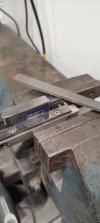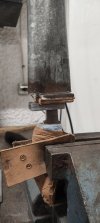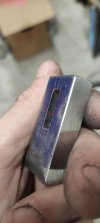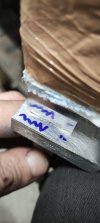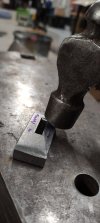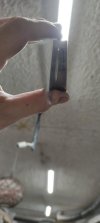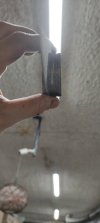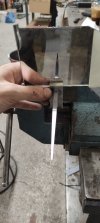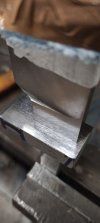- Joined
- Jan 31, 2022
- Messages
- 4
Hey all,
I’m a stock removal knifemaker starting my foray into hidden tangs. I’ve got some questions about process that I’m hoping some of you can give me some guidance on please.
I don’t have a heat treating setup, so I’ve been outsourcing my heat treating until now. What order of operations would you recommend? Profile the blade and leave a good bit of extra material around the tang and shoulders and cut those in post HT? That seems to make sense to me, but then how do I go about cutting in the shoulders on the width of the ricasso? I don’t have a mill so just hoping to file these in by hand. Should I blue back the tang and file them in post HT? Done correctly, does this have any negative repercussions on the strength of the knife? Or should I completely finish out the tang/shoulders prior to HT? This seems risky as I could pretty easily wreck the shoulders while finish grinding the flats, right? I’ve tried grinding in these shoulders with AO belts and my carbide file guide, but have not been able to get clean shoulders on the width of the ricasso this way. I just can’t seem to get the belt to cut in square and flush with the file guide.
Next, if using 1/8” stock, would you still cut in shoulders on the width of the ricasso, or would you just leave flat and press fit the bolster? I tried cutting in shoulders on the width on an 1/8” tang and it definitely leaves a pretty thin piece of material by the time you’re done tapering. I know some believe in not having shoulders on the width of the ricasso at all…should I not bother with these and leave the tang flat and press fit everything, even on bigger knives with thicker stock?
Sorry for the rambling and potentially incoherent spewing of questions….my brain has been working overtime trying to figure this stuff out! Thank you for your time and knowledge…I’m definitely looking forward to getting this process dialled in. Getting my own heat treating setup is definitely my top priority, but I simply can’t wait any longer to start making hidden tangs!
Thanks,
Kieran
I’m a stock removal knifemaker starting my foray into hidden tangs. I’ve got some questions about process that I’m hoping some of you can give me some guidance on please.
I don’t have a heat treating setup, so I’ve been outsourcing my heat treating until now. What order of operations would you recommend? Profile the blade and leave a good bit of extra material around the tang and shoulders and cut those in post HT? That seems to make sense to me, but then how do I go about cutting in the shoulders on the width of the ricasso? I don’t have a mill so just hoping to file these in by hand. Should I blue back the tang and file them in post HT? Done correctly, does this have any negative repercussions on the strength of the knife? Or should I completely finish out the tang/shoulders prior to HT? This seems risky as I could pretty easily wreck the shoulders while finish grinding the flats, right? I’ve tried grinding in these shoulders with AO belts and my carbide file guide, but have not been able to get clean shoulders on the width of the ricasso this way. I just can’t seem to get the belt to cut in square and flush with the file guide.
Next, if using 1/8” stock, would you still cut in shoulders on the width of the ricasso, or would you just leave flat and press fit the bolster? I tried cutting in shoulders on the width on an 1/8” tang and it definitely leaves a pretty thin piece of material by the time you’re done tapering. I know some believe in not having shoulders on the width of the ricasso at all…should I not bother with these and leave the tang flat and press fit everything, even on bigger knives with thicker stock?
Sorry for the rambling and potentially incoherent spewing of questions….my brain has been working overtime trying to figure this stuff out! Thank you for your time and knowledge…I’m definitely looking forward to getting this process dialled in. Getting my own heat treating setup is definitely my top priority, but I simply can’t wait any longer to start making hidden tangs!
Thanks,
Kieran

